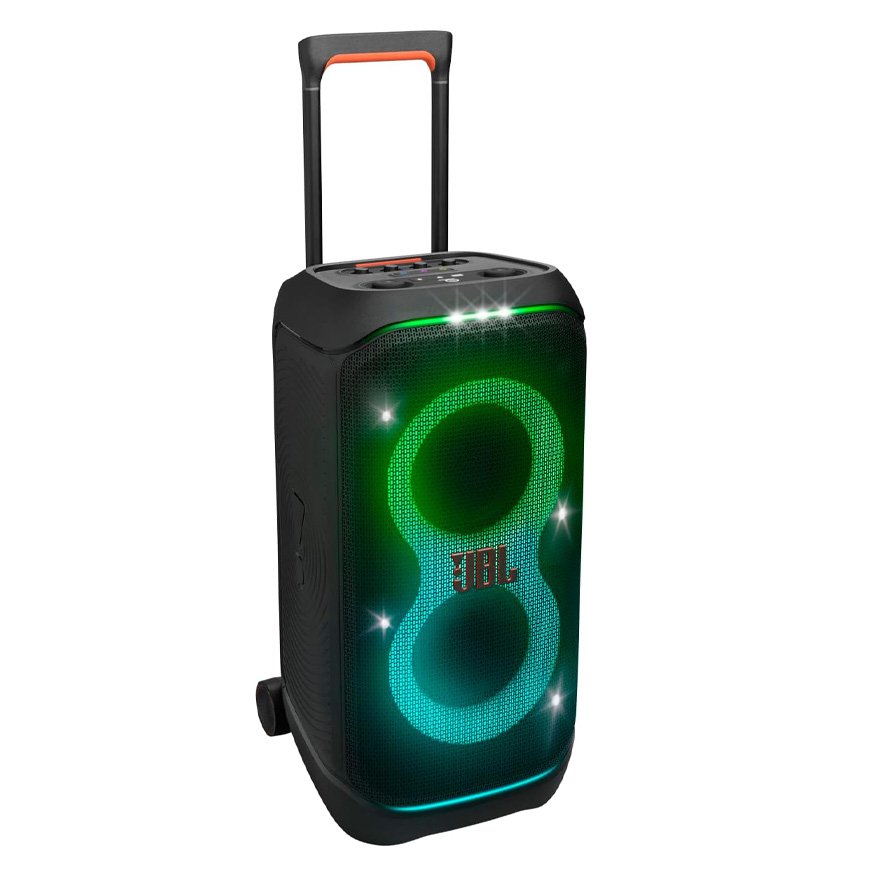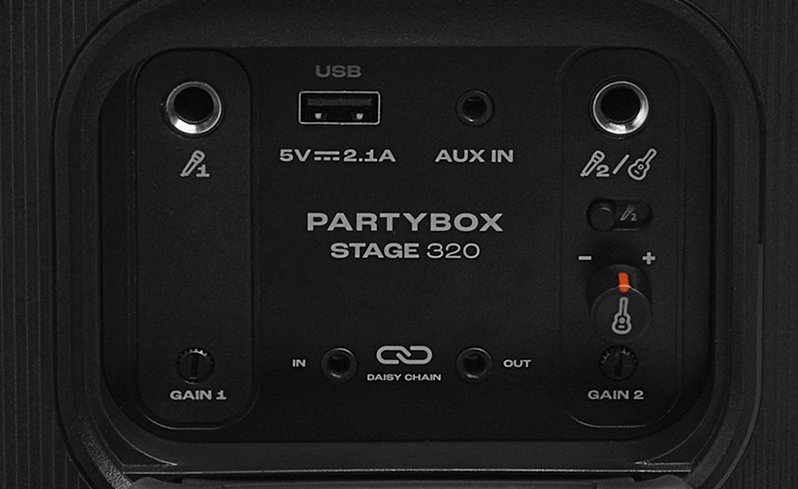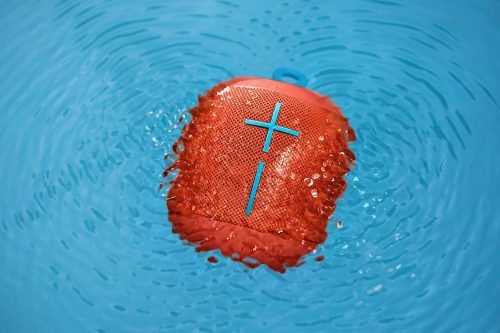The JBL PartyBox 320 was released near the middle of 2024 and offers several significant upgrades to the popular PartyBox 310. The PartyBox 300-series is the largest of the PartyBox range to feature a built-in battery, making it more versatile than the PartyBox 710, 1000, or Ultimate. In this article, we’ll examine how the PartyBox 320 compares to the 310 and whether it’s worth upgrading.
Key Takeaways
- Bluetooth has been updated from 5.1 to 5.4 on the PartyBox 320, supporting Auracast multi-speaker pairing and TWS.
- Although playtime remains the same, the PartyBox 320 has a replaceable battery that can be swapped out in seconds.
- A new, broader wheel design provides improved stability while being transported.
- Lighting effects have been improved, with more coverage across the speaker.
- Sound quality is improved, with more clarity in the vocal range, making songs sound more detailed and vibrant.

Winner
JBL PartyBox Stage 320
The PartyBox Stage 320 ushers in the next generation of the PartyBox range with improved sound quality, lighting effects, and multi-speaker pairing.
JBL PartyBox 310 vs Partybox Stage 320 Specs
| Model | PartyBox 310 | PartyBox 320 |
| Water Resistance | IPX4 | IPX4 |
| Output Power | 240W | 240W |
| Bluetooth Version | 5.1 | 5.4 |
| Battery Life | Up to 18 Hours | Up to 18 Hours |
| Charging Time | 3.5 Hours | 3 Hours |
| Frequency Response | 45 Hz – 20 kHz | 40 Hz – 20 kHz |
| Woofers | Dual 6.5″ | Dual 6.5″ |
| Tweeters | Dual 2.25″ | Dual 1″ |
| Wheels | Yes | Yes |
| TWS | Yes | Yes |
| Party Pairing | No | Yes (Auracast) |
| Weight | 38.4 lbs | 41.7 lbs |
| Dimensions | 12.8 x 27 x 14.5″ | 13.19 x 26.34 x 15.16″ |
| App Support | JBL PartyBox | JBL PartyBox |
| Price: | Check Price | Check Price |
Design, Build, & Durability
Summary: The PartyBox Stage 320 has several differences in design compared to the PartyBox 310. The 320 is slightly shorter than the 310 by just shy of an inch, measuring 26.34″ tall. The front grille design has also changed, with a different pattern – the same style as that found on the new PartyBox Club 120. JBL has also removed the discreet stands on the side of the PartyBox 310, and unlike the previous model, the PartyBox 320 isn’t advertised to support horizontal placement. JBL’s more recent logo also replaces the distinctive red JBL tag found on the front of the 310.
Editor’s Note: In September 2024, JBL released a white version of the PartyBox 320, giving it an additional advantage over the JBL PartyBox 310.
Durability
Winner: JBL PartyBox 320
The JBL PartyBox 310 and 320 sport a durable design that protects it in a party environment. While neither speaker is particularly well suited to outdoor use in challenging weather, they both sport an IPX4 water-resistance rating, which protects them from drizzle, accidental splashes, and light sprays. The new mesh design feels more durable, with the tighter-knit pattern providing additional protection from accidental damage.
Portability
Winner: PartyBox 320
The PartyBox 320 is slightly heavier than the PartyBox 310, weighing 41.7 lbs compared to 38.4 lbs. It retains the telescopic handle, which, in unison with the built-in wheels, makes the PartyBox 300-series easy to move around despite its weight. The handle has seen slight improvements in itself, and it can now lock into specific lengths, making it better suited to individual situations.
The wheel design on the PartyBox Stage 320 has been significantly improved, with a broader surface coverage that provides more stability. These new wheels perform better on rough terrain in particular. While the 320 is a slightly smaller but wider speaker, there are no noticeable differences in portability due to these minor size adjustments.
Lighting Effects
Winner: PartyBox 320
Vibrant lighting is a key feature of most party speakers and the PartyBox range is renowned for its bright, active lighting. The PartyBox 320 improves the lighting effects of the 310, replacing the two distinct LED rings around the drivers with a single, figure-8 design that increases the amount of light the speaker produces. Additionally, JBL has added an LED strip to the tops and bottoms of the speaker to create additional visual nuance. An additional eight small white LEDs run vertically along the left and right sides of the speaker.
Using the JBL PartyBox mobile app, you can control the colors, patterns, and even the specific light areas you would like to adjust.
Controls, Connectivity & App Support
Summary: The JBL PartyBox Stage 320 retains many of the same controls as the 310 but with noteworthy improvements to connectivity. The 320 has upgraded Bluetooth, moving from 5.1 to 5.4. Usually, newer Bluetooth versions come with negligible improvements, but 5.4 sees the introduction of Auracast support, which allows you to connect multiple speakers to the same source device using what JBL has branded as “multi-speaker pairing.”
Inputs & Outputs
Winner: PartyBox 320
The PartyBox 320 retains most of the inputs and outputs in the previous model with a few small changes. There are two microphone inputs, one of the two supporting guitar inputs, and an associated toggle button. JBL has moved the microphone volume controls to the top of the speaker, with only the guitar input’s volume being controlled via the rear of the speaker. It retains the USB-A, aux-in connection, and daisy chain ports but says goodbye to the TWS pairing button. TWS pairing can still be done using the mobile app, where it’s titled “Stereo Group.”
Controls
Winner: PartyBox 320
The entire control panel has been changed on the PartyBox 320, now featuring raised buttons similar to those found on both the PartyBox 110 and 120. These buttons become much easier to use without a clear sight of the control panel.
The microphone controls have become more prominent and robust, with four dials that allow for changing volume, bass, treble, and echo. These controls only affect the audio from the microphone and will not adjust the sound of regular music played through the speaker. The 320 now has a visible label letting users know that the buttons are for microphone control, which was ambiguous in the 310.
We also now have access to a few somewhat novel soundboard buttons that play a soundbite over the audio. Unfortunately, they are limited to preset samples and don’t support custom audio samples.
The PartyBox Stage 320 falls behind the 310 in one area, and that’s the inclusion of a 12V DC input. This port wasn’t essential, but it gave more versatility to the speaker, especially when used away from home.
Bluetooth
Winner: PartyBox 320
Bluetooth upgrades aren’t always a big deal, but the move from 5.1 to 5.4 is a noteworthy evolution in Bluetooth speakers as it allows connecting multiple speakers directly to a single source device. Traditionally, multispeaker connections were either TWS or relied on a speaker to take the master role and broadcast to the other connected speakers. The PartyBox Stage 320 can be connected en-mass to a single phone, tablet, or any other Bluetooth source device.
The Bluetooth on both PartyBox speakers is otherwise reliable and effectively retains the connection at range. Additionally, because the 320 has such low latency, it becomes a viable home multimedia speaker too.
App Support
Winner: PartyBox 320
The 320 and 310 use JBL’s PartyBox app (supported on Android and Apple). Despite both speakers using the same app, the 320 has more comprehensive control options. Toggle between four preset EQ modes (JBL signature, movie, vocal, chill) or create your sound signature using the custom 5-band graphic EQ. The app also provides speaker pairing control with TWS (True Wireless Stereo) pairing, available under the group pairing option.
Audio Performance
Summary: The JBL PartyBox Stage 320 sounds better than its predecessor, with a brighter, more detailed sound that allows vocals to come through with lifelike clarity. It can also retain its clarity at high volume levels a little better than the PartyBox 310 can, representing an improvement to the dynamics. Both speakers are able to reach similar volume levels, loud enough for most house parties.
Frequency Response
Winner: PartyBox 320
The frequency response range has been improved on the new PartyBox 320, providing an additional 5 Hertz of depth to the low end. Despite the deeper bass extension, the 320 has a much more refined sound than the 310. The PartyBox 310 is a speaker that falls victim to excessive bass, drowning out the midrange and reducing vocal clarity.
The PartyBox 320 is a brighter-sounding speaker with much more detail in the midrange and highs. It removes the muddiness that the 310 would sometimes fall victim to and instead provides the clarity we haven’t heard before within the 300-series.
Neither speaker is what one would consider balanced, but the vibrant party-style design is not made to be a reference speaker. Instead, the 320 creates a thriving party sound with deep bass while retaining the midrange vocal clarity and nuance within the treble range.
For an additional punch, you can activate the bass boost feature, bringing the bass even forward and making it ideal for electronic dance music.
Soundstage & Dynamics
Winner: PartyBox 320
Both speakers have the same front-facing driver configuration with two vertically aligned 6.5″ woofers in the center and two horizontally aligned 2.25″ tweeters near the top. As a result, the soundstage between these two speakers is unchanged. When the PartyBox 310 was placed horizontally, the soundstage never improved. JBL’s removal of the horizontal placement feet didn’t impact the overall soundstage, with both speakers having a passable yet somewhat narrow dispersion.
The PartyBox 310 was never a slouch in its dynamics, reaching high volume levels while retaining details and clarity. The PartyBox Stage 320 performs similarly in this regard, with a slightly improved dynamic range that
Volume
Winner: PartyBox 320
Both speakers can breach over 100dB SPL, making them loud enough to host gatherings of 30 to 50 people indoors easily. Still, the PartyBox Stage 320 comes out on top, producing just a few more decibels than the PartyBox 310 in volume tests. At these volume levels, it isn’t easy to pick the two apart in comparison without the use of measuring tools. The PartyBox 320 retains slightly more detail and clarity at higher volume levels.
Battery
Summary: The PartyBox 310 and 320 have practically the same battery life, lasting up to 18 hours at moderate volume. With lights enabled and volume at around 60 to 70%, they both last around 7 hours. The PartyBox 320, however, has an innovative replaceable battery which is a big benefit over the 310. The PartyBox Stage 320 also charges around 30 minutes quicker than its predecessor.
Playtime
Winner: PartyBox 320
The PartyBox 310 and 320 have similar battery capabilities, providing up to 18 hours of playtime from a charge. However, the battery life depends on the volume level and lighting effects. Real-world scenarios will net you around 7 to 9 hours of playtime with the lighting effects enabled, which is a little shorter than the 310, but the 320’s battery is slightly more efficient and can recharge in around 30 minutes less than the PartyBox 310.
The biggest benefit the PartyBox 320 has over the 310 when it comes to battery performance is the fact that JBL has elevated the PartyBox 300-series to feature a swappable battery, something that Soundboks has been doing for several years now. This ability improves your speaker’s longevity and can prove extremely useful when hosting a lengthy party.
Switching between battery and AC power will also impact the audio, as when the speaker is plugged in, it can achieve slightly more volume.
Price & Value
The JBL PartyBox 320 retails for $50 more than the PartyBox 310, with price drops expected on the 310 within the next several months. At around $600, it’s not a cheap speaker, but its quality justifies the high price point.
Conclusion
Overall, the PartyBox Stage 320 is a step up from the PartyBox 310. The improvements to sound quality are remarkable and a selling point on their own, but when coupled with the new Auracast pairing support and vibrant new lighting effects, it’s a no-brainer which of these two speakers is worth investing in. If you already have the 310 and are considering upgrading, you will see significant benefits.
- Powerful JBL Pro Sound: Two 6.5″ woofers that deliver clean, precise, deep bass even at top volume and a pair of 25mm dome tweeters that produce crystal clear highs. Loud enough to fill a space the size of a tennis court with music.
- Futuristic lightshow: Take all that sound and add a thrilling lightshow featuring starry lights, cool light trails, and strobe light effects—all synced to your beat.
















